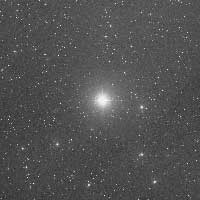Alpha Andromedae (α And / α Andromedae) is the brightest star in the Andromeda constellation, which is located immediately northeast of Pegasus. It also has the traditional names Alpheratz and Sirrah (or Sirah). As a connecting star to Pegasus, it is also known as Delta Pegasi (δ Peg), though this name is no longer used (another such doubly-named connecting star is Beta Tauri). It is located 97 light years from Earth. A magnitude 2.2 blue-white binary, Alpheratz is composed of two close-orbiting stars that can be distinguished only by careful spectroscopic analysis. The larger of the two is about ten times the size of the smaller, and they orbit each other with a period of 96.7 days. Classified as spectral-type B8, the pair is about 200 times brighter than the Sun, and has a surface temperature of about 13,000 kelvins. The larger of the two stars comprising Alpheratz is the brightest known of an odd group of stars known as "mercury-manganese stars." It displays an anomalously high abundance of mercury, gallium, manganese, and europium in its atmosphere, and an unusually low concentration of other elements. These anomalies are believed to be the result of separation of elements due to the inward pull of the star's gravity. It is also classified as an Alpha2 Canum Venaticorum type variable star and its brightness varies from magnitude +2.02 to +2.06 with a period of 23.19 hours. The names Alpheratz and Sirrah both derive from the original Arabic name, سرةالفرس şirrat al-faras, "navel of the horse". (سرة alone is sirrah.) Location The star's location is shown in the following chart of the Andromeda constellation Retrieved from "http://en.wikipedia.org/"
|
|
||||||||||||||||||||||||||||||||||||||||||||||||||||||||||||||||||||||||||||||
